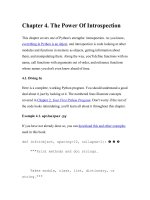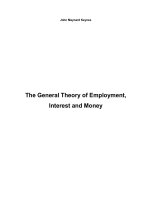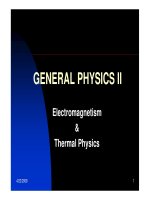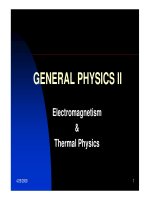Chapter 4: The Chromosome Theory of Inheritance
Bạn đang xem bản rút gọn của tài liệu. Xem và tải ngay bản đầy đủ của tài liệu tại đây (4.12 MB, 86 trang )
Chapter 4: The Chromosome
Theory of Inheritance
Chapter 4 of the textbook: Genetics: From Genes
to Genomes, 4th edition (2011), Hartwell H. et. al.
CHAPTER OUTLINE:
4.1 Chromosomes: The Carriers of Genes
4.2 Mitosis: Cell Division That Preserves
Chromosome Number
4.3 Meiosis: Cell Divisions That Halve
Chromosome Number
4.4 Gametogenesis
4.5 Validation of the Chromosome Theory
1
VNU-University of Science - DNThai
Down syndrome: One extra chromosome 21
has widespread phenotypic consequences
Trisomy 21, gives rise to an
abnormal phenotype, including a
wide skull, an unusually large
tongue, learning disabilities, as well
as heart disorders, rapid aging, and
leukemia.
How can one extra copy of
a chromosome that is itself of
normal size and shape cause such
wide-ranging phenotypic effects?
VNU-University of Science - DNThai
/>mal/images/Down_Syndrome_
Karyotype.jpg
2
4.1 Chromosomes: The Carriers of
Genes
Evidence that Genes Reside in the Nucleus
• 1667 – Anton van Leeuwenhoek
– Microscopist
– Semen contains spermatozoa (sperm animals).
– Hypothesized that sperm enter egg to achieve fertilization
• 1854-1874 – confirmation of fertilization through
union of eggs and sperm, main parts are their nuclei
– Recorded frog and sea urchin fertilization using microscopy and
time-lapse drawings and micrographs
3
VNU-University of Science - DNThai
Genes reside in chromosomes
• 1880s – innovations in microscopy and staining techniques
identified thread-like structures
• Provided a means to follow movement of chromosomes during
cell division
• Mitosis - nuclear division that generates two daughter cells
containing the same number and type of chromosomes as
parent cell
• Meiosis - Nuclear division that generates gametes (egg and
sperm) containing half the number of chromosomes found in
other cells
4
VNU-University of Science - DNThai
Fertilization: The union of haploid
gametes to produce diploid zygotes
• Fertilized eggs carry matching sets of chromosomes, one set
from maternal gamete and one set from paternal gamete
• Gametes are haploid (n) – carry only a single set of
chromosomes
• Zygotes are diploid (2n) – carry two matching set of
chromosome
• Mitosis ensures that all cells of developing individuals have
identical 2n chromosome sets
5
VNU-University of Science - DNThai
Diploid versus haploid: 2n versus n
Most body cells are diploid (each
chromosome pair has one
maternal and one paternal copy)
Meiosis haploid (n) gametes
In Drosophila, 2n = 8, n = 4
In humans , 2n = 46 and n = 23
Fig. 4.2
VNU-University of Science - DNThai
6
Nomenclature for Drosophila genetics
• Homologous chromosomes contain the same set of genes, but can have
different alleles for some genes
• Nonhomologous chromosomes carry completely unrelated sets of genes
Fig. 4.3
VNU-University of Science - DNThai
7
Karyotype of a human male
• Karyotype – micrograph of stained chromosomes arranged in
homologous pairs
– Sex chromosomes – unpaired X and Y chromosome
– Autosomes – all chromosomes except X and Y
• Each homologous pair arranged in order of decreasing size
Fig. 4.4
8
VNU-University of Science - DNThai
Sex chromosomes: one chromosome
pair determines sex in grasshoppers
• W. S. Sutton studied meiosis in great lubber grasshoppers
• Before meiosis, testes cells had 24 chromosomes
– 22 in matched pairs (autosomes) and 2 unmatched (large = X and smaller
= Y)
• After meiosis, two types of sperm were formed and
separated:
– 1/2 of sperm had 11 chromosomes and an X
– 1/2 of sperm had 11 chromosomes and a Y
• After meiosis, only one type of egg was produced
– All had 11 chromosomes plus an X
• Then Sutton did the fertilization as follow:
VNU-University of Science - DNThai
9
The great lubber grasshopper
• Fertilization of egg with sperm carrying an X XX female
• Fertilization of egg with sperm carrying a Y XY male
• Sutton concluded that the X and Y chromosomes determine sex
The great lubber grasshoppers
(Brachystola magna)
In this mating pair, the smaller
male is astride the female
Fig. 4.5
VNU-University of Science - DNThai
10
The X and Y chromosomes determine
sex in humans
• Children receive an X chromosome from their mother, but
either an X or Y chromosome from their father
• Results in 1:1 ratio of females-to-males
11
VNU-University of Science - DNThai
Fig. 4.6 a, b
Species variations in sex determination
• In Drosophila, ratio of X chromosomes to autosomes
determines gender
• In humans, presence or absence of Y chromosome
determines gender
• Abnormal numbers of X or Y chromosomes have different
effects in humans and flies
Table 4.1
12
VNU-University of Science - DNThai
4.2 Mitosis: Cell Division That
Preserves Chromosome Number
Cell cycle – repeating pattern of cell growth and division or
alternates between interphase and mitosis
Most of cell growth occurs during
G1 and G2 phases
Some terminally differentiated cells
stop dividing and arrest in G0 stage
Chromosomes replicate to form
sister chromatids during S phase
VNU-University of Science - DNThai
Fig. 4.7a
13
Chromosomes replicate during S phase
• G1 phase – chromosomes
are not duplicating or
dividing. Length of time
varies in different cell types
• S phase – duplication of
chromosome into sister
chromatids
• G2 phase – synthesis of
proteins required for
mitosis
14
VNU-University of Science - DNThai
During interphase, cells grow and
replicate their chromosomes
Interphase – period of cell cycle between divisions. During
interphase, cells grow and replicate their chromosomes
• Within nucleus:
− G1, S, and G2 phase – cell growth, protein synthesis,
chromosome replication
• Outside of nucleus: Formation of microtubules radiating out
into cytoplasm, crucial for interphase processes
− Centrosome – organizing center for microtubules located
near nuclear envelope
− Centrioles – pair of small darkly stained bodies at center of
centrosome in animals (not found in plants)
15
VNU-University of Science - DNThai
During mitosis, sister chromatids
separate and two daughter nuclei form
The five stages of mitosis and their major events
• Prophase - (from the Greek pro- meaning “before”), chromosomes
condense and become visible
• Prometaphase – (“before middle stage”), spindle forms and sister
chromatids attach to microtubules from opposite centrosomes
• Metaphase – (“middle stage”), chromosome align at the cell's
equator
• Anaphase – (from the Greek ana- meaning “up” as in “up toward
the poles”), sister chromatids separate and move to opposite poles
• Telophase – (from the Greek telomeaning “end”), chromosomes
decondense and are enclosed in two nuclei
16
VNU-University of Science - DNThai
Prophase -Chromosomes condense
Fig. 4.8a
– Inside nucleus
• Chromosomes condense into structures suitable for replication.
• Nucleoli begin to break down and disappear.
– Outside nucleus
• Centrosomes which replicated during interphase move apart and migrate
to opposite ends of the nucleus.
• Interphase microtubules disappear and are replaced by microtubules that
rapidly grow from and contract back to centrosomal organizing centers.
VNU-University of Science - DNThai
17
Prometaphase: The spindle forms
Fig. 4.8b
–
–
–
–
Nuclear envelope breaks down
Microtubules invade nucleus
Chromosomes attach to microtubules through kinetochore
Mitotic spindle – composed of three types of microtubules
• Kinetochore microtubules – centrosome to kinetochore
• Polar microtubules – centrosome to middle of cell
• Astral microtubules – centrosome to cell’s periphery
18
VNU-University of Science - DNThai
Metaphase: Chromosomes align at the
cell’s equator
Fig. 4.8c
• Chromosomes align on the metaphase plate with sister
chromatids facing opposite poles
• Forces pushing and pulling chromosomes to or from
each pole are in balanced equilibrium
19
VNU-University of Science - DNThai
Anaphase: Sister chromatids move to
opposite spindle poles
Fig. 4.8d
• Centromeres of all chromosomes divide simultaneously
• Kinetochore microtubules shorten and pull separated
sister chromatids to opposite poles (characteristic V
shape)
20
VNU-University of Science - DNThai
Telophase: Identical sets of
chromosomes are enclosed in two nuclei
Fig. 4.8e
• Spindle fibers disperse
• Nuclear envelope forms around group of chromosomes
at each pole
• One or more nucleoli reappear
• Chromosomes decondense
• Mitosis complete
VNU-University of Science - DNThai
21
Cytokinesis is the final stage of cell
division
Fig. 4.8f
• Begins during anaphase but not completed until after
telophase
• Parent cells split into two daughter cells with identical
nuclei
22
VNU-University of Science - DNThai
Cytokinesis – The cytoplasm divides,
producing two daughter cells
• Animals have contractile
ring that contracts to form
cleavage furrow
• Plants have cell plate that
forms near equator of cell
• Organelles (e.g.
ribosomes, mitochondria,
Golgi bodies) are
distributed to each
daughter cell
Fig. 4.9
VNU-University of Science - DNThai
23
Checkpoints
help regulate
the cell cycle
• At each
checkpoint, prior
events must be
completed before
the next step of
the cycle can
begin
VNU-University of Science - DNThai
24
4.3 Meiosis: Cell Divisions That Halve
Chromosome Number
• Somatic cells make up vast majority of cells in the
organism. They are in G0 or are actively going through
mitosis
• Germ cells are precursors to gametes
– Set aside from somatic cells during embryogenesis
– Become incorporated into reproductive organs
– Only cells that undergo meiosis produce haploid
gametes
25
VNU-University of Science - DNThai









